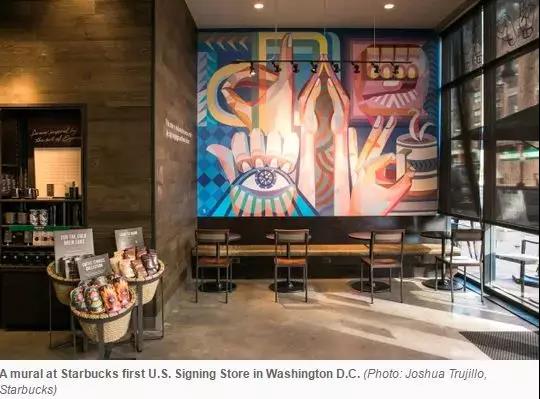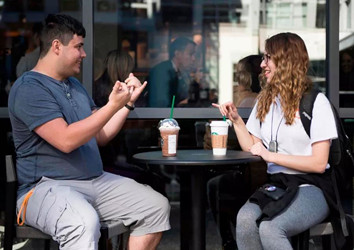星巴克新店温暖人心
Starbucks opens first U.S. sign language store - with murals, tech pads and fingerspelling
星巴克开了第一家有壁画、高科技的平板电脑和手语的分店。
The storefronts along Washington's bustling H Street Northeast are lit up with familiar names and logos: Petco. Whole Foods.
位于繁华的华盛顿H街的这些店面都有相似的店名和标志:Petco. Whole Foods.
There is also a Starbucks. Or, more specifically, S-T-A-R-B-U-C-K-S spelled out in the hand symbols of American Sign Language.
还有一个单词“Starbucks”,更确切地说是“S-T-A-R-B-U-C-K-S”,是用美国手语中手势符号拼出来的。
That fingerspelling is one way to spot the coffee giant's first U.S. signing store, where 24 deaf, hard-of-hearing and hearing employees run the shop using ASL.
这个手势语也突显了这家咖啡巨头第一家美国境内手语店的特点,店内由24名使用美国手语的耳聋、有听力障碍和听力正常的员工经营。
“My identity is accepted here,” said Crystal Harris, a barista at the signing store. “Deafness has many faces.”
手语店里的咖啡师Crystal Harris说:“我在这里得到了认可,耳聋也有很多事情可做。”

The store is just blocks from Gallaudet University, a 150-year-old institution and the world’s only university designed for deaf and hard-of-hearing students.
这家店距离高立德大学只有几条街区远,这所拥有150年历史的大学是世界唯一一所为耳聋和弱听学生设计的大学。
The shop mirrors Starbucks’s first signing store, which opened in Kuala Lumpur, Malaysia, in 2016.
这家店仿照了星巴克2016年第一家开在马来西亚吉隆坡的手语店。
Customers from the outside can spot "Starbucks" written out in fingerspelling beneath the main logo and on large table umbrellas.
顾客从外面可以看见主标志下面和大桌伞上用手势语拼出的单词“Starbucks”。
And on the inside, what may appear like any other Starbucks cafe has been specifically laid out and decorated to celebrate deaf culture.
店内就和其他星巴克咖啡店一样,餐具摆放和装饰都体现了耳聋人士的文化。
The store employs 24 workers who are all conversant in American Sign Language.
店内雇佣了24位精通美国手语的员工。
Customers can communicate in ASL or write their orders on a tech pad. Rather than wait to hear their names called at the end of the bar, customers look up to a screen showing when their drinks are ready.
顾客可以用美国手语交流或者在高科技的平板上写下自己要点的餐品,顾客不会等着吧台叫自己的名字,而是抬头看屏幕,可以取餐时屏幕会显示。
The store was also remodeled to maximize light and open lines of sight - high top tables or tall stacks of cups, for example, limit visibility for people signing to each other.
店里也重新装修以使光线充足视野开阔,因为像高桌子或堆得很高的杯子(这些摆设)都会阻碍人们看到彼此的手语。
Non-signing customers are also encouraged to use visual cues. Rather than sign that the store didn’t carry chamomile tea, for example, one employee waved his hand across his neck - signaling “no” - and then pointed to a printed menu with other options.
不使用手语的顾客也被建议使用可视提示。比如店里没有标示不提供甘菊茶,员工可以在脖子上挥手来表示“没有”,然后再在打印的菜单上指出其他选择。
Store manager Matthew Gilsbach moved from California's Bay Area to run the signing location.
咖啡店经理Matthew Gilsbach是从加州湾区调来管理这家手语店的。
At one point in his three and a half years at the company, Gilsbach said he was stunned to meet a deaf Starbucks district manager.
Gilsbach说在这家公司工作三年半左右时,遇到了一位耳聋的星巴克区域经理,他很惊讶。
"I thought, wait, there's a deaf district manager?" Gilsbach said. "What's going on?"
Gilsbach说:“我当时在想‘等等,还会有耳聋的区域经理?怎么回事?’”
Any disbelief that a deaf person could take on a management or executive role is precisely the kind of stigma Starbucks and deaf community advocates aim to combat.
不相信耳聋人士能承担起管理或执行的角色恰好是星巴克以及为耳聋群体辩护的人一致要改变的误解。
Howard Rosenblum, chief executive of the National Association of the Deaf, said that companies may hire deaf employees at lower levels, but those opportunities rarely extend up the chain.
全美聋哑人协会会长Howard Rosenblum说公司可能会以更低的标准雇佣耳聋员工,但很少提供向上发展的机会。

Some companies show signs of progress: Microsoft's chief accessibility officer, Jenny Lay-Flurrie, is deaf and has fought to expand accessibility for employees with disabilities.
一些公司有了明显改善:微软首席辅助官Jenny Lay-Flurrie耳聋,一直努力为残障员工拓展工作机会。
Still, the deaf community's rate of unemployment and underemployment sits at a staggering 70 percent, Rosenblum said.
Rosenblum说:“但耳聋群体的失业率和未充分就业率竟然达到了70%。”
“The manager is always a hearing person because there's a perception of limited ability with deaf people,” Rosenblum said.
Rosenblum说:“经理都是听力正常的人,因为普遍认为耳聋人士能力有限。”
Not so at the H Street Starbucks.
但在H街的星巴克情况并非如此。
Employee Kylie Garcia had just been promoted from a barista to a shift supervisor.
员工Kylie Garcia就是从咖啡师做到了领班。
Garcia grew up as the only deaf individual in a non-signing, hearing family, and she knows firsthand how difficult it is for deaf people to find jobs.
Garcia在一个不使用手语、听力正常的家庭长大,是家里唯一耳聋的人,她对耳聋人士找工作的难度深有体会。
Garcia previously worked in a Starbucks kiosk at a Target store where her sole job was to make drinks - never interacting with customers and often being shut out of conversations with other baristas.
Garcia此前在一家塔吉特的星巴克饮品站工作,她唯一的工作就是制作饮品,从未与顾客交流过,其他咖啡师也不愿意和她聊天。
“People turned down offering me jobs because they aren't willing to take the risk,” Garcia said.
Garcia说:“他们不给我分配工作,因为他们不愿意冒险。”
Pamela Pipes, a hearing barista who is also a sign language interpreter, moved from Raleigh, N.C., to work at the D.C. signing store.
Pamela Pipes是一位听力正常的咖啡师,也是一位手语翻译,从北卡罗来纳州的罗利被调来华盛顿特区的手语店工作。
Here, "the tables have turned," Pipes said, in that hearing customers are going to have to figure out how to navigate and communicate in deaf spaces.
Pipes说:“在这儿情况恰恰相反,”在这家店里听力正常的顾客要搞懂怎么在一个都是耳聋人士的店里进行交流。


